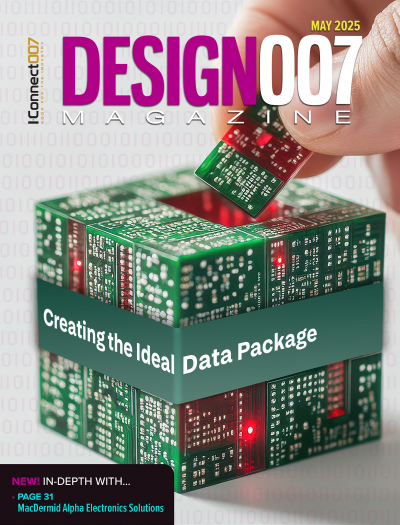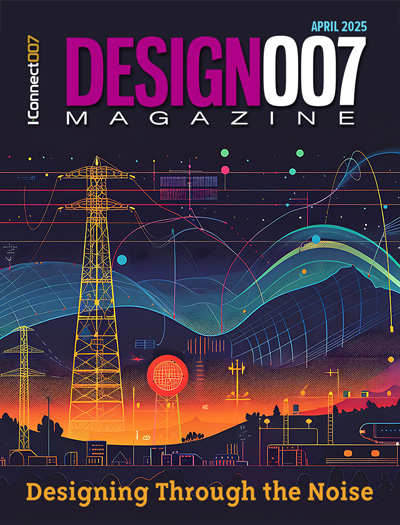-

- News
- Books
Featured Books
- design007 Magazine
Latest Issues
Current Issue
All About That Route
Most designers favor manual routing, but today's interactive autorouters may be changing designers' minds by allowing users more direct control. In this issue, our expert contributors discuss a variety of manual and autorouting strategies.

Creating the Ideal Data Package
Why is it so difficult to create the ideal data package? Many of these simple errors can be alleviated by paying attention to detail—and knowing what issues to look out for. So, this month, our experts weigh in on the best practices for creating the ideal design data package for your design.

Designing Through the Noise
Our experts discuss the constantly evolving world of RF design, including the many tradeoffs, material considerations, and design tips and techniques that designers and design engineers need to know to succeed in this high-frequency realm.
- Articles
- Columns
- Links
- Media kit
||| MENU - design007 Magazine
Beyond Design: Faster than a Speeding Bullet
March 9, 2016 | Barry Olney, In-Circuit DesignEstimated reading time: 1 minute
In a previous Beyond Design column, Transmission Lines, I mentioned that a transmission line does not carry the signal itself, but rather guides electromagnetic energy from one point to another. The speed of a computer does not depend intrinsically on the speed of electrons, but rather on the speed of energy transfer between electronic components. Electron flow in a multilayer PCB is extremely slow—about 10 mm per second—so, how does the signal travel so fast, how fast does it actually transfer information and what are the limitations?
In optical communications, electrons don’t carry the signal—photons do. And we all know that photons travel at the speed of light. So surely, optical fibers must transmit information much faster than copper wires or traces on a multilayer PCB? Actually, photons and electrons transmit data at the same speed. The limiting factor is the relative permittivity (dielectric constant) of the medium in which the signal propagates.
An optical fiber is a cylindrical dielectric waveguide made of low-loss materials such as fused silica glass. It has a central core in which light is guided, and embedded in an outer cladding of slightly lower refractive index. The silica glass used has a dielectric constant (Er or Dk) = 3.78 @25GHz. Whereas, for instance, Panasonic’s new Megtron 7, low Dk, glass PCB laminate has an Er = 3.3 at the same frequency.
To read this entire article, which appeared in the February 2016 issue of The PCB Design Magazine, click here.
Suggested Items
Happy’s Tech Talk #40: Factors in PTH Reliability—Hole Voids
07/09/2025 | Happy Holden -- Column: Happy’s Tech TalkWhen we consider via reliability, the major contributing factors are typically processing deviations. These can be subtle and not always visible. One particularly insightful column was by Mike Carano, “Causes of Plating Voids, Pre-electroless Copper,” where he outlined some of the possible causes of hole defects for both plated through-hole (PTH) and blind vias.
Trouble in Your Tank: Can You Drill the Perfect Hole?
07/07/2025 | Michael Carano -- Column: Trouble in Your TankIn the movie “Friday Night Lights,” the head football coach (played by Billy Bob Thornton) addresses his high school football team on a hot day in August in West Texas. He asks his players one question: “Can you be perfect?” That is an interesting question, in football and the printed circuit board fabrication world, where being perfect is somewhat elusive. When it comes to mechanical drilling and via formation, can you drill the perfect hole time after time?
The Evolution of Picosecond Laser Drilling
06/19/2025 | Marcy LaRont, PCB007 MagazineIs it hard to imagine a single laser pulse reduced not only from nanoseconds to picoseconds in its pulse duration, but even to femtoseconds? Well, buckle up because it seems we are there. In this interview, Dr. Stefan Rung, technical director of laser machines at Schmoll Maschinen GmbH, traces the technology trajectory of the laser drill from the CO2 laser to cutting-edge picosecond and hybrid laser drilling systems, highlighting the benefits and limitations of each method, and demonstrating how laser innovations are shaping the future of PCB fabrication.
Day 2: More Cutting-edge Insights at the EIPC Summer Conference
06/18/2025 | Pete Starkey, I-Connect007The European Institute for the PCB Community (EIPC) summer conference took place this year in Edinburgh, Scotland, June 3-4. This is the third of three articles on the conference. The other two cover Day 1’s sessions and the opening keynote speech. Below is a recap of the second day’s sessions.
Day 1: Cutting Edge Insights at the EIPC Summer Conference
06/17/2025 | Pete Starkey, I-Connect007The European Institute for the PCB Community (EIPC) Summer Conference took place this year in Edinburgh, Scotland, June 3-4. This is the second of three articles on the conference. The other two cover the keynote speeches and Day 2 of the technical conference. Below is a recap of the first day’s sessions.


